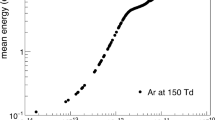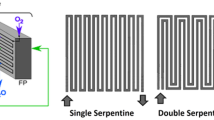Abstract
A mathematical framework for the coupling of gas networks to electric grids is presented to describe in particular the transition from gas to power. The dynamics of the gas flow are given by the isentropic Euler equations, while the power flow equations are used to model the power grid. We derive pressure laws for the gas flow that allow for the well-posedness of the coupling and a rigorous treatment of solutions. For simulation purposes, we apply appropriate numerical methods and show in an experimental study how gas-to-power might influence the dynamics of the gas and power network, respectively.













Similar content being viewed by others
References
Chertkov M, Backhaus S, Lebedev V (2015) Cascading of fluctuations in interdependent energy infrastructures: gas–grid coupling. Appl Energy 160:541–551
Zeng Q, Fang J, Li J, Chen Z (2016) Steady-state analysis of the integrated natural gas and electric power system with bi-directional energy conversion. Appl Energy 184:1483–1492
Zlotnik A, Roald L, Backhaus S, Chertkov M, Andersson G (2016) Control policies for operational coordination of electric power and natural gas transmission systems. Am Control Conf 2016:7478–7483
Herty M, Müller S, Sikstel A (2019) Coupling of compressible Euler equations. Vietnam J Math. https://doi.org/10.1007/s10013-019-00353-7
Banda M, Herty M, Klar A (2006) Coupling conditions for gas networks governed by the isothermal Euler equations. Netw Heterog Media 1:295–314
Banda M, Herty M, Klar A (2006) Gas flow in pipeline networks. Netw Heterog Media 1:41–56
Bressan A, Canic S, Garavello M, Herty M, Piccoli B (2014) Flow on networks: recent results and perspectives. Eur Math Soc 1:47–111
Brouwer J, Gasser I, Herty M (2011) Gas pipeline models revisited: model hierarchies, nonisothermal models, and simulations of networks. Multiscale Model Simul 9:601–623
Colombo R, Garavello M (2008) On the Cauchy problem for the p-system at a junction. SIAM J Math Anal 39:1456–1471
Reigstad G (2015) Existence and uniqueness of solutions to the generalized Riemann problem for isentropic flow. SIAM J Appl Math 75:679–702
Reigstad G (2014) Numerical network models and entropy principles for isothermal junction flow. Netw Heterog Media 9:65
LeVeque R (2002) Finite volume methods for hyperbolic problems. Cambridge texts in applied mathematics. Cambridge University Press, Cambridge
Gyrya V, Zlotnik A (2019) An explicit staggered-grid method for numerical simulation of large-scale natural gas pipeline networks. Appl Math Model 65:34–51
Pfetsch ME, Koch T, Schewe L, Hiller B (eds) (2015) Evaluating gas network capacities. Society for Industrial and Applied Mathematics, Philadelphia
Kolb O, Lang J, Bales P (2010) An implicit box scheme for subsonic compressible flow with dissipative source term. Numer Algorithms 53:293–307
Bienstock D (2015) Electrical transmission system cascades and vulnerability. Society for Industrial and Applied Mathematics, Philadelphia
Heuck K, Dettmann K, Schultz D (2013) Elektrische energieversorgung. Springer Vieweg, Berlin
Göttlich S, Herty M, Schillen P (2016) Electric transmission lines: control and numerical discretization. Optim Control Appl Methods 37:980–995
Fokken E, Göttlich S, Kolb O (2019) Optimal control of compressor stations in a coupled gas-to-power network. arXiv:1901.00522
Egger H (2018) A robust conservative mixed finite element method for isentropic compressible flow on pipe networks. SIAM J Sci Comput 40:A108–A129
Zhou J, Adewumi M (1996) Simulation of transients in natural gas pipelines. SPE Prod Facil 11:202–207
Gugat M, Herty M, Klar A, Leugering G, Schleper V (2012) Well-posedness of networked hyperbolic systems of balance laws. In: Leugering G, Engell S, Griewank A, Hinze M, Rannacher R, Schulz V, Ulbrich M, Ulbrich S (eds) Constrained optimization and optimal control for partial differential equations. Springer, Basel, pp 123–146
Gugat M, Herty M, Müller S (2017) Coupling conditions for the transition from supersonic to subsonic fluid states. Netw Heterog Media 12:371–380
Grainger J, Stevenson W, Chang G (2016) Power system analysis. McGraw-Hill series in electrical and computer engineering: power and energy. McGraw-Hill Education, New York
Kolb O (2014) On the full and global accuracy of a compact third order WENO scheme. SIAM J Numer Anal 52:2335–2355
Naumann A, Kolb O, Semplice M (2018) On a third order CWENO boundary treatment with application to networks of hyperbolic conservation laws. Appl Math Comput 325:252–270
Zimmerman RD, Murillo-Sanchez CE, Thomas RJ (2011) MATPOWER: steady-state operations, planning, and analysis tools for power systems research and education. IEEE Trans Power Syst 26:12–19
Humpola J, Joormann I, Kanelakis N, Oucherif D, Pfetsch M, Schewe L, Schmidt M, Schwarz R, Sirvent M (2017) GasLib: a library of gas network instances. Technical report
Gugat M, Schuster M (2018) Stationary gas networks with compressor control and random loads: optimization with probabilistic constraints. Math Probl Eng 2018:7984079
Göttlich S, Korn R, Lux K (2019) Optimal control of electricity input given an uncertain demand. Math Methods Oper Res. https://doi.org/10.1007/s00186-019-00678-6
Acknowledgements
The authors gratefully thank the BMBF project ENets (05M18VMA) for the financial support.
Author information
Authors and Affiliations
Corresponding author
Additional information
Publisher's Note
Springer Nature remains neutral with regard to jurisdictional claims in published maps and institutional affiliations.
Appendix: A Proof of Lemma 3
Appendix: A Proof of Lemma 3
The following two technical results are the key ingredients to prove Lemma 3.
Lemma 13
Let \(g \in C^1(\mathbb {R}^+, \mathbb {R}^+)\)be a non-negative function, \(g\ge 0\), and let G be given by \(G(\rho ) = \int _\rho ^{\rho _l}g(s)\mathrm{d}s\). Then There holds
- 1.
If \(\rho ^2g(\rho ) \overset{\rho \rightarrow 0}{\rightarrow } 0\), then \(\rho G(\rho ) \overset{\rho \rightarrow 0}{\rightarrow } 0\).
- 2.
If \(\rho G(\rho ) \overset{\rho \rightarrow 0}{\rightarrow } 0\), then \(\liminf _{\rho \rightarrow 0}\rho ^2g(\rho ) =0\).
Proof
-
1.
By assumption \(\rho ^2g(\rho ) \overset{\rho \rightarrow 0}{\rightarrow } 0\). For \(m \in \mathbb {N}\) choose \(\rho _m >0\) such that \(g(\rho )\le \tfrac{1}{m\rho ^2}\) for \(\rho <\rho _m\). Now choose \(\rho _{m,0}<\rho _m\) so small that
$$\begin{aligned} \rho _{m,0} \left( \int _{\rho _m}^{\rho _l}g(s)\mathrm{d}s -\frac{1}{m\rho _m}\right) \le \frac{1}{m} . \end{aligned}$$(69)Then, for \(\rho <\rho _{m,0}\), there holds
$$\begin{aligned} \rho \int _{\rho }^{\rho _l}g(s)\mathrm{d}s&\le \rho \int _{\rho _m}^{\rho _l}g(s) \mathrm{d}s + \frac{1}{m}\rho \int _{\rho }^{\rho _m}\frac{1}{s^2}\mathrm{d}s\nonumber \\&= \rho \left( \int _{\rho _m}^{\rho _l}g(s) \mathrm{d}s-\frac{1}{m\rho _m}\right) +\frac{1}{m}\nonumber \\&\le \frac{2}{m}. \end{aligned}$$(70)Therefore \(\lim _{\rho \rightarrow 0}\rho \int _{\rho }^{\rho _l}g(s)\mathrm{d}s \le \tfrac{2}{m}\) for all \(m \in \mathbb {N}\). As \(g\ge 0\), we also have \(0\le \lim _{\rho \rightarrow 0}\rho \int _{\rho }^{\rho _l}g(s)\mathrm{d}s\). Summarizing, we get \(\lim _{\rho \rightarrow 0}\rho G(\rho ) = \lim _{\rho \rightarrow 0}\rho \int _{\rho }^{\rho _l}g(s)\mathrm{d}s = 0\).
-
2.
We prove by contradiction: Assume there are \(\rho _0>0\) and \(a >0\) such that \(\rho ^2g(\rho ) \ge a\) for \(\rho < \rho _0\). Then \(g(\rho )\ge \tfrac{a}{2}\tfrac{1}{\rho ^2}\) for such \(\rho \). Therefore
$$\begin{aligned} \rho \int _\rho ^{\rho _l}g(s)\mathrm{d}s \ge \rho \int _{\rho _0}^{\rho _l}g(s) \mathrm{d}s + \rho \frac{a}{2}\int _{\rho }^{\rho _0} \frac{1}{s^2} \mathrm{d}s \rightarrow 0 + \frac{a}{2} \rho \left[ -\frac{1}{s} \right] _\rho ^{\rho _0} \rightarrow \frac{a}{2}, \end{aligned}$$(71)which contradicts \(\rho G(\rho ) \overset{\rho \rightarrow 0}{\longrightarrow } 0\). \(\square \)
Lemma 14
Let \(g \in C^1(\mathbb {R}^+, \mathbb {R}^+)\), \(g\ge 0\) and \(\liminf _{\rho \rightarrow 0} \rho ^2g(\rho ) = 0\). Let also \(\left( \rho ^2g(\rho ) \right) ^\prime \ge 0\). Then, \(\limsup _{\rho \rightarrow 0} \rho ^2 g(\rho ) = \liminf _{\rho \rightarrow 0} \rho ^2 g(\rho ) = 0\).
Proof
We prove by contradiction. Let \(\limsup _{\rho \rightarrow 0} \rho ^2 g(\rho ) > \liminf \rho ^2 g(\rho )\). Then it is easily seen that \(\liminf _{\rho \rightarrow 0} \left( \rho ^2g(\rho ) \right) ^\prime = -\infty < 0\) resulting in a contradiction. \(\square \)
Rights and permissions
About this article
Cite this article
Fokken, E., Göttlich, S. & Kolb, O. Modeling and simulation of gas networks coupled to power grids. J Eng Math 119, 217–239 (2019). https://doi.org/10.1007/s10665-019-10026-6
Received:
Accepted:
Published:
Issue Date:
DOI: https://doi.org/10.1007/s10665-019-10026-6




